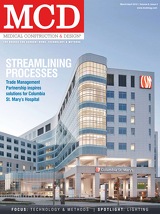Medical Construction & Design (MCD) is the industry's leading source for news and information and reaches all disciplines involved in the healthcare construction and design process. To view more past issues go to: http://mcdmag.epubxpress.com
Page 44 of 70
TECHNOLOGY & METHODS
BIM: Using 3-D modeling and clash detection, the team mapped the existing services, determining optimal points to perform the tie-ins. This avoided the need for a 25-foot-deep open excavation.
The clinicians'
request that data be available on a wireless device can impact
multiple systems. Interop
coordination of the 24-inch-diameter supply and return lines in a 12-foot- diameter connecting tunnel to the hospital. The electrical subcontractor used the models to visualize and lay out the main power feeds. Subsequently, the two
subcontractors used the 3-D models to perform virtual clash detection, eliminating confl icts in the layouts and future installation. The models were used to develop accurate shop drawings for prefabrication of many system elements. The collaboration supported the fast-track schedule on this congested construction site. Similarly, BIM enabled the project
team to plan routing and installation of the air-handling equipment and chilled-water piping on the interstitial fl oor at level four of the patient tower. This allowed the team to optimize the fl oor-to-ceiling height for a signifi cant positive impact on the budget.
MINIMIZING CONSTRUCTION IMPACT
The IPD team's use of BIM also enabled solutions to minimize the impact of construction activities on the ground. For example, a plan was needed for a complex set of utility connections at the front entrance of the hospital that were scheduled early in the construction phase: An underground tie-in to a waterline and a storm system and routing of new power, cable and voice/data services into a new, two-story connecting corridor. Using 3-D modeling and clash
detection, the team mapped the existing services, determining optimal points to perform the tie-ins. This avoided the need for a 25-foot-deep open excavation, which would have created a signifi cant disruption at the main entrance to the hospital. The plan also provided routing of the new
40 Medical Construction & Design | March/April 2012
power, cable and voice/data services into the ceiling space of the new corridor — assuring everything fi t as designed when the components were installed. Similarly, an integration of BIM
with total station survey data was used for more accurate transfer of the structural detailing to the construction site. For example, the team downloaded coordinates and elevations from the BIM model to the total station survey system to lay out the structure on the site, including all placement points for embeds and rebar. The team also used the
integration of BIM and total station to devise and execute an alternative to a 45-foot- deep excavation at the main intersection to lay the 12-foot- diameter pipe connecting the new central utility plant with the hospital. Instead, the pipe was
www.mcdmag.com
MODEL: SKANSKA
